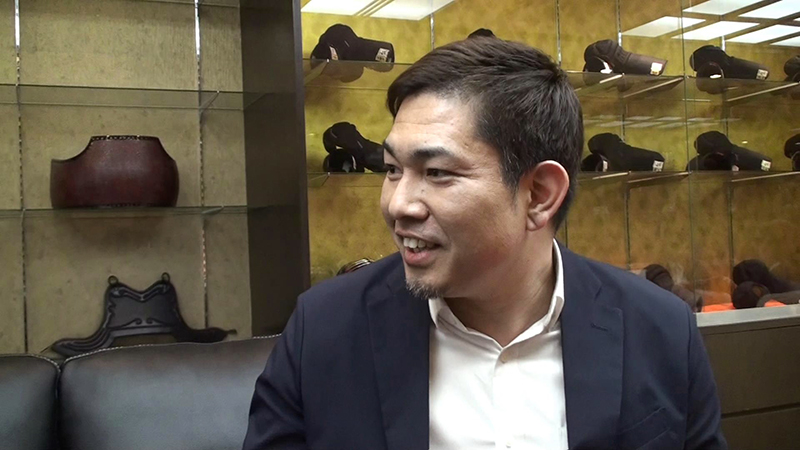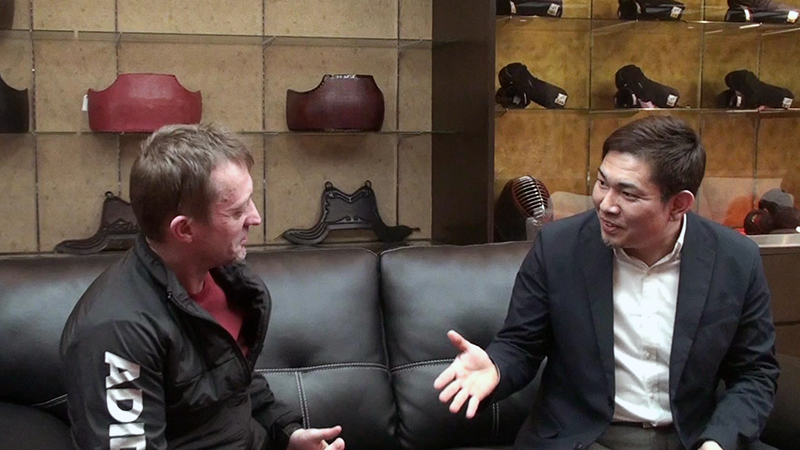
Takahiro Hayashi – born in 1978, from Shiga. He has never failed a promotion exam and became the youngest person at age 35 to reach 7th dan. Works at Tozando.
Alec Bennet – born in 1970, from New Zealand. Chief editor of magazine Kendo World, Professor at Kansai University.
Hayashi “Alec, it’s been a while.”
Bennet “Yes, we last met in October at the corporate competition.”

H “Today, I hope to chat with you about many things regarding Kendo equipment. Currently, most of the Kendo equipment on the market, both inside and outside Japan, are made to fit the physique of a Japanese person. But people in Europe, Oceania and America, as well as other places where Kendo is practiced, have a different frame compared to the Japanese. Does this not cause problems?”
B “Usually not. It can become a problem for people who are exceptionally large, but for someone like my size it’s not a problem.”
H “People from Northern Europe tend to be large. Like people from Sweden.”
B “Yes, and the Netherlands.”
H “They have longer limbs and a shorter torso compared to the Japanese. Their waist is higher. And their faces are smaller than the Japanese, even with their large bodies…”
B “Yes, that’s true.”
H “Like an S-size men and an XXL do.”

B “There are many cases where the Kote and the Do do not match.”
H “I think the length of the forearm is very different. Even some Japanese people have very thin wrists but their forearm muscles are quite large. For these type of people, the tube of the Kote ends up widening into a shape of a horn. The shape of the Kote looks awkward, but it cannot be helped because that is a natural Kote for that person.”
B “For adult equipment sold overseas, there is inevitably a greater need for size variation compared to Japan. In other words, Kenshi overseas come in all kinds of shapes and sizes compared to those in Japan.”

H “The current Kendo equipment goes back to old Japanese artisans and shops making martial arts equipment and standardizing the equipment based on the body size of Japanese people. For example, the standardized sizes or the length and strength of the tube have all been decided. Now that Kendo has spread so widely overseas, as a shop selling martial arts equipment, we need to start suggesting standards that match the present reality.”
B “The length of the wooden or bamboo sword is also based on the physique of people back in the day, right? The average height of a Japanese person used to be 158 cm.”
H “That is very short compared to now.”
B “Yes, it is more than 10 cm shorter than the average height of young Japanese people today.”
H “The Shinai did originally did not have any standard length, and it was 4 or 5 shaku (1 shaku is about 30 cm), and there were even Shinai that were like spears.”
B “Yes. It must have been at a time when thrusting was a popular skill. At the end of the Edo era, martial arts schools were made and people from different schools of martial arts gathered and decided the current length of the shinai.”
H “More than 150 years later, not only the physique but the society has changed a lot.”

B “ The rules of Kendo have changed somewhat too. Before, you could thrust the shinai to the chest, but now it’s an illegal move. The senior high school body, junior high school body, and the police all have slightly different rules depending on the organization.”
H “That’s true.”
B “The tsubazeriai (pushing each other’s sword guard) rule is another example.”
H “Yukodatotsu, another words, claiming an “ippon” has hardly changed. But now there is much more detailed regulations concerning violation rules and the time lapse. This addresses the negative things in the past generations of Kendo.”
B “So it is from the present day concern over the importance of safety.”
 | Did you like what you've just read? Check this out. |









